

Stress test: My experience with the stress level measurement of smartwatches
The Smart Watch's stress measurement doesn't work the way I want it to. That stresses me out. Two test devices, a month, a horror film and an interview later, I've still learnt a few things. An experience report.
Many smartwatches can now measure stress levels. Or at least they pretend to be able to. I wanted to take a closer look and, on the advice of Andrea Jacob, I got myself the Garmin Vivoactive 3 Music. This watch also feels light and comfortable on my slim wrist and makes a very good impression on me.

The smartwatch displays the stress level as a number between 0 and 100. Unlike other measured values such as heart rate, number of steps or stairs climbed, it is not immediately clear what the value means and what is being measured. According to Garmin, the stress level is derived from the heart rate variability. If the heart beats very regularly, the watch displays a low value, while a very irregular heartbeat indicates stress.
However, the pulse is very irregular in everyday life anyway. Even I can say that with certainty, although I am a complete layman in the medical field. Just when I get up in the morning, my pulse rate rises from under 70 to well over 100, which is probably why the watch can only detect stress if I don't move for at least 30 seconds. The measurement can be set to permanent or carried out manually. In permanent mode, it simply doesn't deliver a result when I'm on the move.
So far, so good. However, there is one problem: the stress level measurement often doesn't work for me even when I'm standing still. The watch then complains that I should keep still (yes, yes) or check the fit on my wrist (it fits perfectly).
After a few days, I realise that the heart rate measurement doesn't always work properly either. Otherwise my heart rate wouldn't drop from 150 to 90 within a minute on the road bike. If the heart rate isn't always correct, it's no wonder that the stress measurement doesn't measure a value.
Continue with the Samsung Galaxy Watch
So I can't really get to grips with the stress measurement. So I change my watch and grab the Samsung Galaxy Watch, which is still here because Luca tested it. This block fits me less well than the Garmin watch, but I still seem to have better luck with the measurement results here.
The principle is the same as with Garmin. Even with this smartwatch, nothing can be measured during movement and the stress level is calculated from the heartbeat variability. I'm just saying that because the measurement shows something like an ECG. Samsung's information on this is meaningless: "The stress tracker measures certain biomarkers to determine your stress level."
I want to face typical stressful situations and compare the measurement results with how I feel. But I can forget about a few of the ideas, such as shopping in crowded shopping centres on Saturdays. That doesn't work because I'm on the move. Another thing that reliably stresses me out is commuting on crowded trains. You can't get much out of that either. When I'm on the suburban train, it's sometimes possible to measure, but the most stressful moments are getting on, off and changing trains, and again nothing can be measured because there's too much movement. There are still two or three ideas left that I can try out.
Self-experiment 1: reading the newspaper
Most people categorise me as a rather quiet person. But when I'm reading the newspaper, I'm capable of surprisingly choleric outbursts, in the style of "Inside out":



So I pick up another printed product of local quality journalism and inform myself about outrageous scandals and the great injustice in this world. Result: I am totally relaxed.
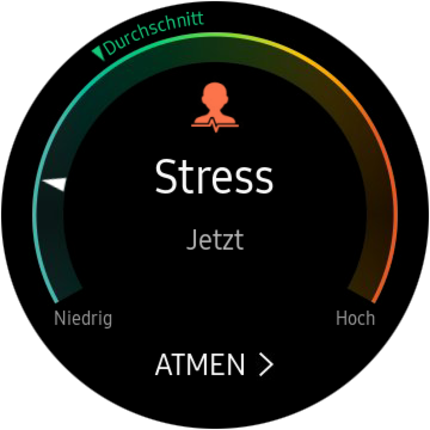
But is that true? It's not that easy to say, because relaxed doesn't necessarily mean that I'm happy and content. Conversely, being very tense doesn't necessarily mean that I have a problem. Falling in love is a huge stress in a way. Even a scary film gives us a kind of stress that we obviously want - otherwise we wouldn't do it to ourselves voluntarily.
Reading the newspaper certainly puts me in a bad mood, but I wouldn't call it stress. That requires stronger stuff. So I confidently turn to the online quality medium 20min.ch and immediately find what I'm looking for.
Media should write positively about migration
The topic of migration is, of course, ideal for getting the walls up. Some people are already upset that something like migration even exists and let others know about it in millions of hateful comments. This in turn annoys those who were cool at first. In the end, everyone gets upset. Me too.
But what really annoys me here is that I don't know what exactly I'm supposed to be upset about. As a media professional, I naturally don't find it funny that someone wants to dictate to the media how they should report on something. On the other hand, is that even true? Or is someone just trying to make a scandal out of their fingers again? I do have the impression that outrage management is being practised here. And that upsets me even more, although it's probably less serious.
These overlapping outrages condense into an inedible lump. Now I should be stressed enough to get the level on the watch to spike. And indeed: the watch shows my condition absolutely correctly.

Self-experiment 2: Watching a horror film
This was not my idea. I know very little about films and even less about horror films. But sitting opposite me is TV, film and cinema expert Luca Fontana. He recommends the new "It" to me.
As I'm pressed for time, I have to have the film today and rush into Orell Füssli. But they only have the old "It" there. As I've never seen that one either, I just buy this one.
The It goes to great lengths: it bubbles blood from the sewer, bares its vampire teeth and threatens to eat the children. But loud measurement I am deeply relaxed. The graphs show the time between 8 and 9 pm and 9 and 10 pm respectively. The film lasted from 20:15 to 21:45 because only part 1 was on the DVD.
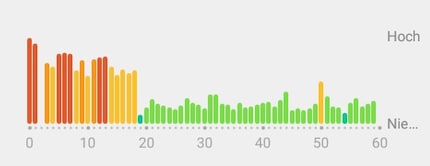
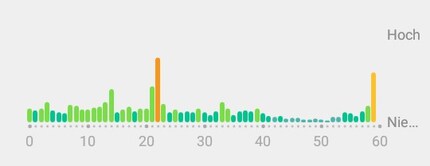
Statistical analysis: one week stress test
I had the stress measurement permanently switched on for a long time. Let's take a look at the results for a whole week
Saturday: Very easy all day, brief stress in the evening
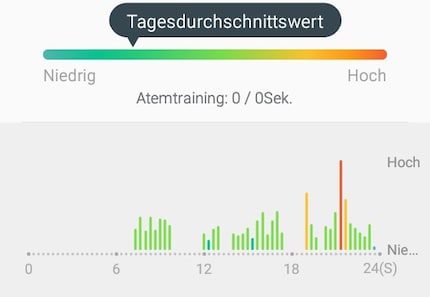
I had a relaxed day, that's true. The gap in the morning is also understandable: I had to help prepare a sailing ship for launching. For the life of me, I can't remember being stressed in the evening. I didn't even go out.
Sunday: Calm with a few moments of stress

The fact that I was stressed at around 9am on Sunday morning is not true. I probably just drank a lot of coffee. The gap in the afternoon was me playing football. A bit of hustle and bustle before and after.
Monday: Stress when I got up, later in the afternoon and in the evening
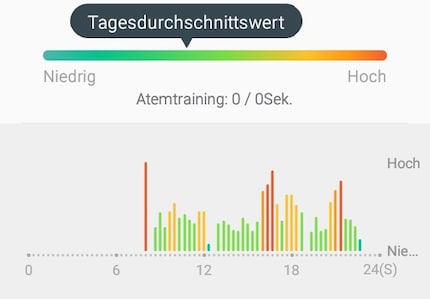
Well, Monday mornings are tedious, and there's a lot to do after getting up: Open windows, wash out coffee maker, make coffee, prepare and eat breakfast, brush teeth, shower, toilet, get dressed, pack things, to the train station. I've also got into the habit of doing a few stretching and strength exercises in the morning. In short: there's a lot to do and there's a certain amount of time pressure, but I don't find it unpleasantly stressful. In contrast, I'm physically passive when I'm working in the office, but I always encounter situations there that I find quite unpleasant and for which I often don't know a good solution. That means stress for me. But the clock hardly shows that.
Tuesday: I can relax best in the office.
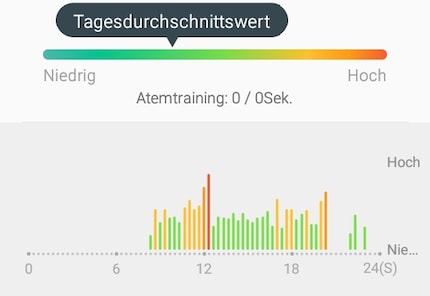
What a load of rubbish! I'm not going to let on that the lunch break under the golden birch trees and the deep blue sky of the beautiful autumn sun was a huge stress. Somehow, according to these smartwatches, eating seems to be a major stress factor. If that's the case, it's definitely positive stress, i.e. eustress.
Wednesday: stressful morning, easy afternoon and evening

In the morning, I did household chores such as washing, cleaning and shopping. But it wasn't stressful at all. In the afternoon, a handyman came and turned my living room into a dust hell. That stressed me out, but the clock didn't notice. My evening exit is also not visible in the graph. My days off are very low-stress, but I'm quite active at times and don't spend the whole day in front of a screen.
Thursday: Good morning, dear worries
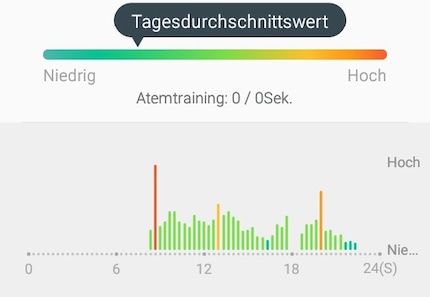
On this day, I got up at about the same time as usual, but didn't put my watch on until after my morning routine. It didn't help: there was still a stress entry at first. In the evening, where there is a gap, I went jogging. I don't know what could have stressed me out later in the evening. It was probably the food again.
Friday: Already halfway through the weekend
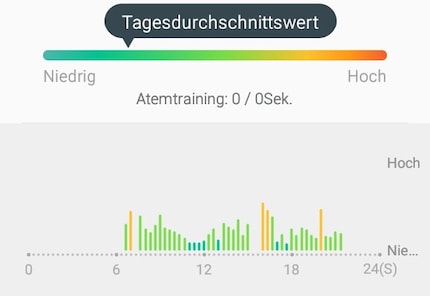
The most relaxed day of the week according to the measurement. Well. At least the really low range at midday is wrong. I had quite a hectic phase then because I had to leave in the afternoon and had some urgent things to do beforehand. In the afternoon, I helped with demolition and waste disposal work. It wasn't stressful, but it wasn't pure relaxation either.
During the long test phase, I occasionally suspected that the watch was unable to distinguish properly between stress and activity. Hence the question: Is there a connection between a high heart rate and high stress? The comparison of the mean values does not show a clear picture. The curves roughly match, but not on 25 October.
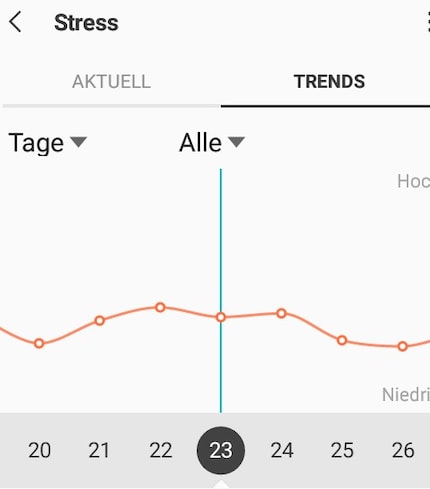

The hour-by-hour comparison suggests even less of a correlation. So I won't bore you with any more graphics.
What the sports scientist thinks of the measurements
In the end, it's all about the question of what stress actually is and how it can be measured. Someone from the medical field should be able to answer that. I turn to Matthias Ludwig, a sports scientist at the Sport Clinic Zurich. He has already subjected our sports editor Patrick Bardelli to a profound stress test. Matthias Ludwig defines stress as follows: "The body has a certain capacity, and if we feel that this is not high enough for a certain problem or task, the body becomes stressed. This manifests itself through numerous indicators such as an increase in cortisone levels or an adrenaline release, which in turn results in an increase in heart rate.
So can stress be measured objectively? In the same way that sports watches do with their infrared chip to determine pulse and heart rate variability? Answer: "It can work under certain conditions." Not exercising is just one of many conditions he mentions: alcohol, coffee, amount and quality of sleep, travelling, social environment and general well-being also have an influence and should be taken into account when interpreting the results. "Headaches can influence the measurement. However, the question then arises as to whether you are stressed because you have a headache or whether you have a headache because you are stressed."
You're better off looking to yourself for the answer than to the clock. Matthias: "If you're stressed, you usually notice it." That's why it usually works like this: Someone realises that something is wrong and then gets it checked out. In contrast, anyone who has ever tried out a smartwatch knows that the order is the other way round: you start by taking measurements and then try to interpret something.
For me, this means that I check the watch instead of the other way round. In other words, I already know whether I'm stressed or not and then check whether the watch is displaying it correctly. This is of course pointless outside of a product test.
In general, Matthias Ludwig does not consider the heart rate measurement of smartwatches and sports watches to be reliable. Even major manufacturers would admit this if asked. That makes sense to me, because otherwise there would be no reason for Garmin to offer additional heart rate chest straps.
My experience: The Samsung Galaxy Watch measures my heart rate quite reliably, as far as I can tell, but there are also dropouts. On Wednesday morning, it first measured nothing for half an hour, then diagnosed me with a pulse of 29 beats per minute. But I'm neither half dead nor Miguel Indurain. If the watch actually takes previous measurements into account in a smart way, it might even realise that this cannot be a valid value.
Matthias also doesn't think much of the idea of using a smart watch to take an ECG. Apple has integrated this into the latest Apple Watch, but only received approval for it in the USA. "A peripheral pulse is measured here - the extent to which a diagnosis can be derived from this is currently being discussed," says the sports scientist.
Conclusion
Although I find stress measurements via wristwatches interesting from a technological point of view, I have come to the conclusion that measuring the heart rate would have to be more accurate and more robust in order to obtain meaningful results. And even then, stress cannot be reduced to this factor. Even if Samsung vaguely hints that their watch takes other factors into account, the function is nothing more than a gimmick for me so far. Under no circumstances would I derive any rules from the results as to how I should lead my life. I prefer to listen to my gut feeling, which has rarely proved me wrong.
My interest in IT and writing landed me in tech journalism early on (2000). I want to know how we can use technology without being used. Outside of the office, I’m a keen musician who makes up for lacking talent with excessive enthusiasm.




